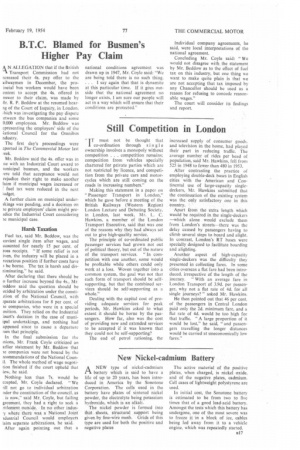Still Competition in London
Page 51

If you've noticed an error in this article please click here to report it so we can fix it.
"IT must not be thought that co-ordination through sin gle ownership involves a monopoly without competition . . . competition remains; competition from vehicles specially chartered for private parties which are not restricted by licence, and competition from the private cars and motorcycles which are still coming on the roads in increasing numbers."
Making this statement in a paper on "Passenger Transport in London," which he gave before a meeting of the British Railways (Western Region) London Lecture and Debating Society, in London, last week, Mr.. L. C. Hawkins, a member of the London Transport Executive, said that was one of the reasons why they had always set out to give high-quality service.
The principle of co-ordinated public passenger services had grown not out of political theory, but out of the nature of the transport services. " In competition with one another, some wOuld be profitable while others could only work at a loss. Woven together into a common system, the goal was not that each form of transport should be selfsupporting, but that the combined services should be self-supporting as a whole."
Dealing with the capital cost of providing adequate services for peak periods, Mr. Hawkins asked to what extent it should be borne by the passengers. How far, also was the cost of providing new and extended services to be accepted if it was known that they could not be self-supporting?
The end of petrol rationing, the increased supply of consumer goods. and television in the home, had played their part in reducing traffic. The average number of rides pet head of population, said Mr. Hawkins, fell from 525 in 1948 to fewer than 480 in 1953.
After contrasting the practice of employing double-deck buses in English cities with the American and Continental use of large-capacity singledeckers, Mr. Hawkins submitted that the continuation of the existing system was the only satisfactory one in this country.
Apart from the extra length which would be required in the single-deckers —which alone would exclude them from London's streets—there was the delay caused by passengers having to climb several steps to board and alight. In contrast, London's RT buses were specially designed to facilitate boarding and alighting.
Another aspect of high-capacity single-deckers was the difficulty they presented in collecting fares. In some cities overseas a flat fare had been introduced, irrespective of the length of the journey. "With an average fare in London Transport of 3.9d. per passenger, why not a flat rate of 4d. for all single journeys?" asked Mr. Hawkins.
He then pointed out that 46 per cent. of the passengers in Central London paid only the 2d. minimum fare, and a flat rate of 4d. would be too high for that traffic. "A large proportion of it would be lost," he said, "and passengers travelling the longer distances would be carried at uneconomically low fares."




























































































